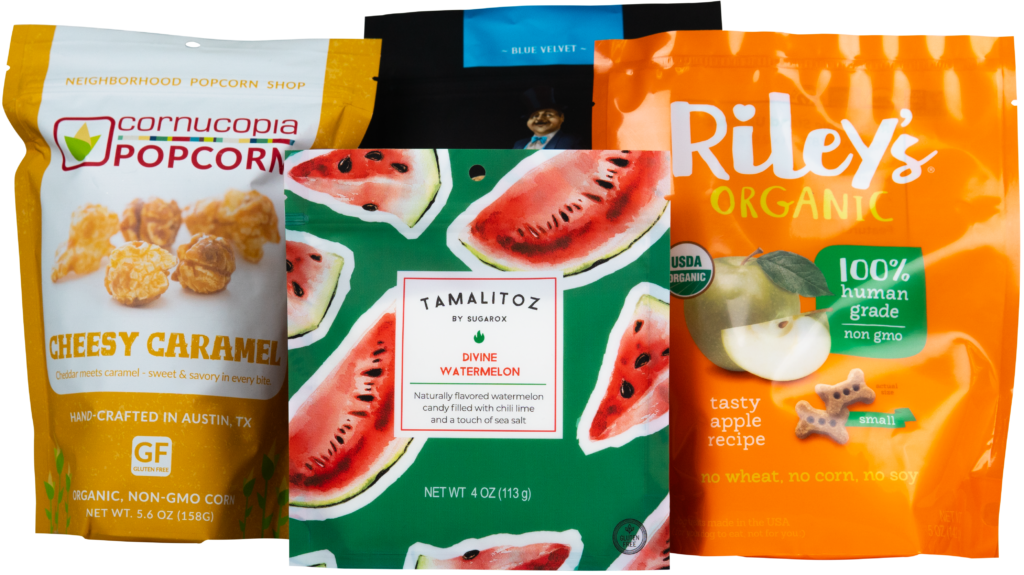One thing you need to know about mylar is that it’s built to last. If shelf life is something you’re considering with how to package your product, mylar is probably the best option. There’s a reason brands worldwide and of every stripe love mylar – because no matter what’s inside, it’s protected.
Mylar’s fancy scientific name is officially biaxially oriented polyethylene terephthalate. It was produced back in the 1950s and was used for insulation, blueprints, kites, and solar filters. Somewhere along the way, though, someone figured out this stuff was the ace in the hole for food storage.
Benefits of Mylar Bags for Food Products
It’s easy to fall in love with mylar packaging; it’s got many positives that businesses love:
- Flexibility
- Light reflective
- Gas impermeable
- Non-porous
- Durable and puncture-resistant
And best of all, it’s an affordable material to work with.
All plastic breathes a little, even food storage buckets and containers; Mylar bags slashes air transfer to almost zero. Typically, mylar bags have a middle layer of aluminum and different plastic layers on the inside and outside, designed for long-term food storage. These bags are strong enough to hold a partial vacuum.
What Are Mylar Bags Made Of?
According to good ole’ Wikipedia, “Mylar, which is theoretically known as BoPET (biaxially-oriented polyethylene terephthalate), a polyester film made from stretched polyethylene terephthalate (PET) and is used for its high tensile strength, chemical and dimensional stability, transparency, reflectivity, gas and aroma barrier properties, and electrical insulation.”
BoPET film was developed in the 1950s by three different companies, Dupont Films, in the USA (they own the trademark, though.) Imperial Chemical Industries (ICI) in the United Kingdom and Hoechst in Germany.
10 Day Turnaround Times?
Need it fast? We can help. Rollstock orders can ship in as little as 10 business days after artwork approval. Formed pouches in as little as 15!
Foods That Can Be Stored in Mylar Bags
There are a few foods that excel when stored in mylar,
- Brown rice
- Whole-wheat flour
- Chips
- Jerky
- Nuts and seeds
- Dried fruits and veggies
- Granola
- Pearl barley
- Fresh foods
How Long Does Food Last in Mylar Bags?
On average, you can get around three years out of a mylar bag, and that’s some serious shelf life. Dehydrated fruits and veggies have a lot of moisture, so they have a shorter shelf life, but it’s still a few years rather than months. When it comes to nuts and seeds, you’ll get around two years due to the natural oil they produce.
Mylar bags come as big as 5 gallons, but unless you’re preparing to live in a bunker, you probably don’t need 33 lbs of rice, which that size would hold. But if you are, we’re here to help make your bags serviceable and cool looking.
Mylar bags come in various thicknesses; the most popular are 3.5mil, 5mil, and 7.5mil. The thick bags are stiffer, and you likely won’t get as much food packed in them. Mylar protects food from light and outside humidity. But oxygen is always in the space between closure and in the actual food itself.
There’s still a lot to learn about mylar bags for food storage, and companies everywhere are testing the limits of what these bags can do to seal in freshness. We’re on board with continued learning of how the packaging process can benefit companies of all different types, whether the product is grains, granola, or natural supplements.
If you’re interested in learning how mylar bags could be a game changer for your business, let’s talk. We’d love to show you samples of how effective the packaging is and how we’ve worked with companies to produce some food-grade mylar bags that look incredible.

